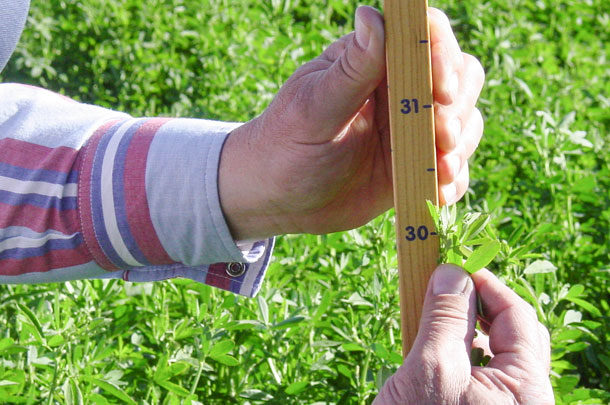Of all the quality factors the producer can control, maturity at cutting is the most important. If the harvest is not timely, preservation processes cannot restore quality already lost. If your goal is to produce premium or supreme quality alfalfa hay, then you need to monitor the maturity of each field and predict when to cut the alfalfa to meet the premium or supreme quality criteria. How can you predict harvest quality of first-cutting alfalfa hay? Examine the length of the longest stem in a sample and the growth stage of the most mature stem.
Development of the stick
The PEAQ method (predictive equations for alfalfa quality), developed in Wisconsin by R. W. Hintz and K. A. Albrecht, provides accurate results. The procedure was adapted to use a prediction stick by measuring the longest stem and determining the growth stage of the most morphologically mature stem in the sample. The prediction stick relates the acid detergent fiber (ADF) in the western U.S. or relative feed value (RFV) in the Midwest determined by PEAQ to stem height on three calibrated scales (vegetative, bud and bloom stages) on the stick. The prediction stick has been evaluated in northern California, southern Idaho and the Midwest, and showed favorable and similar results.

Using the stick to predict forage quality
The PEAQ stick was developed for growers to evaluate the forage quality of the first crop of standing alfalfa. The quality prediction stick is very easy to use and provides a rapid prediction of the forage quality of standing alfalfa. The stick was calibrated (see Figure 1) using the following protocol, and these steps should be followed to use the stick correctly:
-
Select an average 2-square-foot area to sample.
- The area selected should be representative of the field. Select a specific 2-square-foot area to evaluate at random.
-
Determine the growth stage of the most mature stem.
- Sort through the stems in the 2-square-foot area to determine the growth stage (vegetative, bud or bloom) of the most mature stem in that area.
-
Find the single tallest stem; use the correct side of the stick (vegetative, bud or bloom) to predict ADF or RFV.
- Measure the stem from the soil surface to the stem tip (not the tip of the highest leaf). The tallest stem may or may not be the most mature stem. Stretch the stem along the correct side of the stick (vegetative, bud or bloom, which was determined in step two), and record the ADF or RFV value.
-
Repeat steps one through three in at least five representative areas and average the results.
- The more areas evaluated, the better the results reflect the forage quality of the entire field. More than five evaluations would be better, especially for larger or non-uniform fields.
Accuracy and limitations
The quality prediction stick is not intended to replace standard laboratory analysis for forage quality of baled alfalfa hay. Let me say that again: The quality prediction stick is not intended to replace standard laboratory analysis for forage quality of baled alfalfa hay. It is not as accurate as standard laboratory analysis, but is more accurate than visual field estimates of forage quality.
Also, the quality prediction stick estimates the forage quality of the standing crop prior to harvest. It cannot account for losses that may occur while the crop is curing or during harvest and storage. Significant reductions in forage quality are possible if rain occurs while the hay is curing or if the hay is raked or baled under excessively dry conditions and leaf loss occurs. Therefore, to ensure harvested hay is about two points less than an upper limit of ADF (or 15 to 25 RFV points), lead the cutting date a little. For example, if you want less than 30 percent ADF in the bale, you will need to cut at 28 percent ADF.
There are better indicators of forage quality, such as relative forage quality (RFQ) and neutral detergent fiber digestibility (NDFD); however, ADF or RFV criteria are adequate to predict forage quality in this use.

Where and when can the stick be used?
The Western stick has performed well in predicting forage quality of irrigated alfalfa in Idaho, northern California and other Western short growing season areas (two to four cuttings). In Idaho, we recommend that the prediction stick be used only for the first cutting. The Midwestern stick works well in its region. Either stick should be checked for calibration in other areas. Harvest scheduling for dairy quality hay usually requires midsummer cutting at 28 to 30 day intervals. The fall harvest usually has a relatively higher quality at the same maturity than midsummer cuttings.
I recommend sampling the hay bales in the stack with a coring device and submitting the sample to a National Forage Testing Association certified laboratory. To find a certified laboratory, go to the National Forage Testing Association website.
Using the stick as a decision-making tool
The alfalfa quality prediction stick is intended to be a tool to assist growers with harvest decisions. It can help growers determine when to harvest specific fields. For example, the stick may predict the forage quality, as follows:
- Dairy quality – The alfalfa should be cut as soon as possible.
- Above dairy quality – The grower can delay harvest a few days and harvest another field where the alfalfa is not predicted to be significantly above dairy quality.
- Below dairy hay quality – Postpone harvest to maximize yield and target another market such as the horse or stock hay market.
Availability of the prediction stick
The Western ADF prediction stick is available by contacting:
Idaho Hay and Forage Association
Phone: (208) 888-0988
www.idahohay.com
The Midwest RFV PEAQ stick is available from:
Midwest Forage Association
www.midwestforage.org/PEAQ.php FG
Glenn Shewmaker is an extension forage specialist with the University of Idaho. Email Glenn Shewmaker.
References omitted but are available upon request. Click here to email an editor.
PHOTO: Using the PEAQ stick requires measuring the stem from the soil surface to the stem tip (not the tip of the highest leaf) on the correct side of the stick. Photo provided by Glenn Shewmaker.











